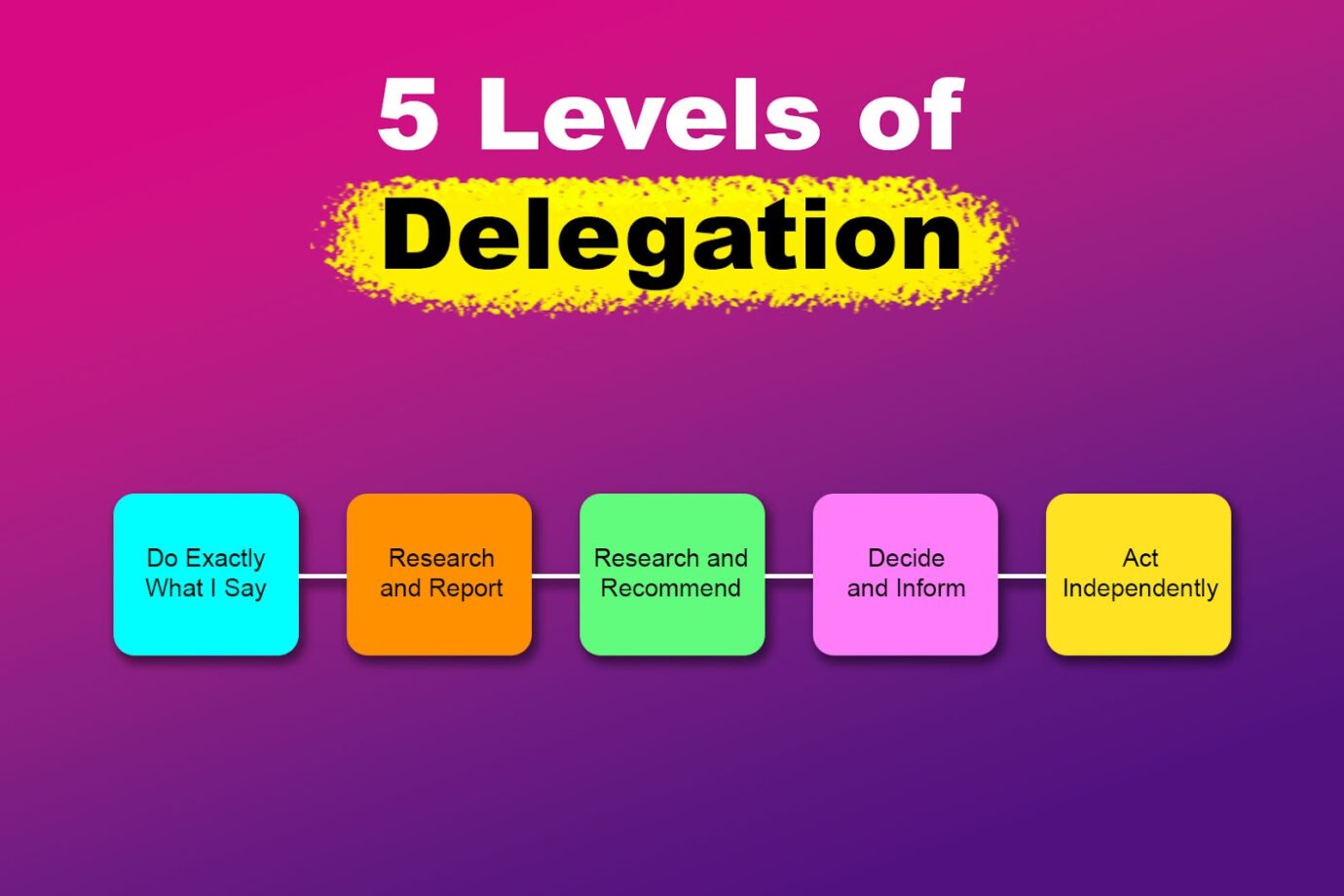Delegation is a cornerstone of effective leadership, yet many managers and team leaders find it challenging. It often fails because leaders overlook that delegation involves varying levels of authority, each with its own expectations.

Michael Hyatt, a renowned business coach, has simplified the delegation process in his book “Free to Focus.” Hyatt introduced a framework of 5 levels of delegation, each tailored to specific tasks and team dynamics.
The 5 Delegation Levels
Let’s explore Michael S. Hyatt’s levels of delegation and see how they can transform your leadership approach. We also included one example for each level.
These are the 5 levels of delegation:
Level 1 – Do Exactly As I Say
This is the most directive form of delegation. The leader provides detailed instructions and expects the team members to follow them precisely. There is no room for interpretation or deviation from the outlined steps. It is ideal when working with someone new to a task.
For example, if a process involves strict compliance, such as legal documentation, Level 1 delegation ensures everything is done as required. While it limits creativity, it provides clarity and mitigates risks.
Learn the 7 steps involved in effective delegation to avoid possible micromanaging.
Level 2 – Research and Report
The leader asks the team members to gather information, analyze it, and report back. The leader retains responsibility for evaluating the information and determining the next steps. This delegation level helps individuals to build their analytical skills and prepare for greater autonomy in the future.
For instance, it is ideal when exploring new vendors for a project. Asking a team member to compile options and report findings allows the leader to make an informed choice without investing time in initial research.
Level 3 – Research and Recommend
At this level, the team member is responsible for researching and recommending a course of action. The leader reviews the recommendation and either approves it or requests revisions before implementation.
This level is excellent for developing future leaders, allowing them to present solutions rather than waiting for instructions.

For example, a marketing associate might propose a new social media campaign, providing both a strategy and rationale. The leader’s role shifts to evaluating the proposal rather than initiating it.
Level 4 – Decide and Inform
Level 4 empowers the team members to make decisions independently but requires them to inform the leader of the actions taken. The leader’s role becomes more of a sounding board or advisor, stepping in only when necessary.
This level is ideal for tasks where the team member has the expertise to act without constant supervision.
For example, a project manager might decide on resource allocation for a project and inform the leader about the changes. This balance of autonomy and accountability ensures alignment without micromanagement.
Level 5 – Act Independently
Level 5 of delegation allows the team member complete autonomy to act within agreed boundaries. There is no need for the leader’s approval or updates unless there’s a significant issue. This level works best with experienced and highly trusted individuals who deeply understand the organization’s goals and values.
For example, a senior team member might oversee an entire department, making decisions aligned with the company’s strategic objectives.
The leadership professor Eli Amdur suggests eight levels of delegating. Check them in this Forbes article.
5 Levels of Delegation Cheat Sheet
If you are a new leader and you want to get used to these practical levels, here’s a handy cheat sheet to help you apply the 5 levels of delegation effectively:
| Level | Name | Delegated Task | When to Use | Ideal For |
| 1 | Do What I Say | Provide detailed instructions. No deviation allowed. | High-risk tasks or new team members. | Novices or trainees. |
| 2 | Research & Report | Gather and analyze information; the leader makes decisions. | Complex decisions requiring data. | Analytical team members. |
| 3 | Research & Recommend | Propose a course of action with rationale; the leader approves. | Building decision-making skills. | Developing leaders. |
| 4 | Decide & Inform | Team member decides; informs leader afterward. | When autonomy is beneficial. | Reliable professionals. |
| 5 | Act Independently | Full autonomy to act within boundaries. | Strategic or routine decisions. | Senior or expert staff. |
Mastering Delegation: The Key to Empowering Your Team
By mastering these levels of delegation, you can effectively manage your teams, fostering both productivity and professional growth.
Delegation isn’t just about offloading tasks—it’s about empowering others to thrive while achieving collective goals.